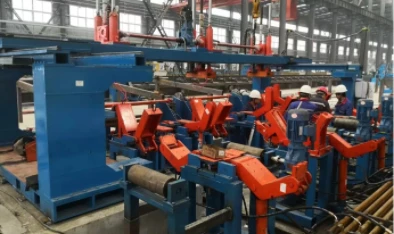industrial cold cut saw
Understanding Industrial Cold Cut Saws Efficiency and Precision in Metal Cutting
In the realm of industrial machining, the choice of cutting tools plays a crucial role in determining the efficiency of manufacturing processes. One such tool that has gained recognition in various industries is the industrial cold cut saw. These saws stand out for their ability to deliver precision cuts with minimal heat generation, making them essential in metalworking applications. This article delves into the features, benefits, and applications of industrial cold cut saws, highlighting their significance in modern manufacturing.
What is an Industrial Cold Cut Saw?
An industrial cold cut saw is a cutting tool used primarily for slicing through metal materials. Unlike traditional saws that operate with high-speed cutting, cold cut saws utilize a circular saw blade that rotates at lower speeds. The cutting process is facilitated by a series of teeth on the blade that shear the metal rather than melt it, hence the term cold cutting. This approach significantly reduces the amount of heat generated during cutting, which can lead to thermal distortion or damage to the material being processed.
Advantages of Cold Cut Saws
1. Precision Cutting One of the primary advantages of cold cut saws is their ability to produce clean, precise cuts with minimal burr. This is particularly beneficial in industries where tight tolerances are crucial, such as aerospace, automotive, and manufacturing sectors.
2. Material Preservation Because cold cut saws generate very little heat, they help preserve the integrity of the material being cut. This not only prevents warping and distortion but also enhances the lifespan of the components produced.
3. Versatility Cold cut saws can be used on a variety of metals, including steel, aluminum, brass, and other alloys. This versatility makes them suitable for a wide range of applications, from large-scale manufacturing to small workshops.
4. Cost-Effectiveness While the initial investment for a cold cut saw may be higher than traditional saws, the long-term savings can be substantial. Reduced tool wear and lower scrap rates lead to decreased operational costs over time.
5. Safer Working Conditions The reduced heat generation and cleaner cutting action contribute to a safer working environment. Workers are less likely to encounter issues related to overheating, and the risk of fire is minimized.
Key Components of Cold Cut Saws
Several key components contribute to the functionality of industrial cold cut saws
industrial cold cut saw

- Blade The blade is engineered with specialized tooth geometry and high-quality materials, such as carbide or bi-metal, to withstand the demands of cutting various metals. The size and thickness of the blade are selected based on the application.
- Drive System Cold cut saws incorporate a powerful motor and a drive system that allows for variable speed settings. This adaptability enables the operator to set the cutting speed according to the material being worked on.
- Clamp System An effective clamping system is essential for securing the workpiece during cutting. This ensures stability and precision, reducing the risk of inaccuracies caused by movement.
Applications of Industrial Cold Cut Saws
Industrial cold cut saws are used in a vast array of applications across different sectors
- Metal Fabrication In metal fabrication shops, cold cut saws are essential tools for producing components that require precise measurements and finishes.
- Automotive Industry Cold cut saws are frequently employed for cutting chassis and structural components in vehicle manufacturing, ensuring high-quality performance and safety standards.
- Construction In construction and fabrication of metal structures, these saws are invaluable for preparing materials like beams, pipes, and tubing.
- Aerospace The aerospace industry relies on cold cut saws for their ability to cut lightweight, yet strong materials with high precision.
Conclusion
Industrial cold cut saws present a combination of efficiency, precision, and versatility in metal cutting applications. Their ability to operate without generating significant heat and to produce accurate cuts with minimal material waste positions them as essential tools in modern manufacturing environments. As industries continue to evolve and demand more from their machining processes, cold cut saws will undoubtedly play a pivotal role in meeting those challenges head-on, all while contributing to safer and more efficient production practices. Embracing this technology not only enhances operational efficiency but also reinforces a commitment to quality and precision in every cut.
-
High Frequency Straight Seam Welded Pipe Production Line-BzZhou Xinghua Machinery Equipment Manufacturing Co., LTD.|Precision Welding, High EfficiencyNewsJul.30,2025
-
High Frequency Straight Seam Welded Pipe Production Line|BzZhou Xinghua|Precision Welding&EfficiencyNewsJul.30,2025
-
High Frequency Straight Seam Welded Pipe Production Line - BzZhou Xinghua|Precision Engineering&EfficiencyNewsJul.30,2025
-
High-Frequency Straight Seam Welded Pipe Production Line-BzZhou Xinghua Machinery Equipment Manufacturing Co., LTD.NewsJul.30,2025
-
High-Frequency Straight Seam Welded Pipe Production Line-BzZhou Xinghua Machinery Equipment Manufacturing Co., LTD.|Precision Manufacturing, High EfficiencyNewsJul.30,2025
-
High Frequency Straight Seam Welded Pipe Production Line-BzZhou Xinghua Machinery Equipment Manufacturing Co., LTD.|Precision Steel Pipe Manufacturing&Industrial EfficiencyNewsJul.29,2025


